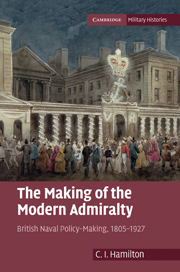Book contents
- Frontmatter
- Contents
- List of tables
- Preface
- Introduction
- 1 Lord Barham's Admiralty: 1805
- 2 Admiralty reform, 1806–1835
- 3 Decision-making at the Admiralty, c. 1806–1830
- 4 Admiralty administration and decision-making, c. 1830–1868. The Graham Admiralty
- 5 The Admiralty reformed again: context and problems, 1868–1885
- 6 Administrative and policy-making responses, c. 1882 onwards
- 7 Fisher and Churchill, and their successors, 1902–1917
- 8 The Naval Staff, planning and policy
- 9 Lord Beatty's Admiralty
- Conclusion
- Appendix 1 First Lords, First Sea Lords and Permanent Secretaries, 1805–1927
- Appendix 2 Acronyms and definitions
- Manuscript sources and select bibliography
- Index
Introduction
Published online by Cambridge University Press: 03 May 2011
- Frontmatter
- Contents
- List of tables
- Preface
- Introduction
- 1 Lord Barham's Admiralty: 1805
- 2 Admiralty reform, 1806–1835
- 3 Decision-making at the Admiralty, c. 1806–1830
- 4 Admiralty administration and decision-making, c. 1830–1868. The Graham Admiralty
- 5 The Admiralty reformed again: context and problems, 1868–1885
- 6 Administrative and policy-making responses, c. 1882 onwards
- 7 Fisher and Churchill, and their successors, 1902–1917
- 8 The Naval Staff, planning and policy
- 9 Lord Beatty's Admiralty
- Conclusion
- Appendix 1 First Lords, First Sea Lords and Permanent Secretaries, 1805–1927
- Appendix 2 Acronyms and definitions
- Manuscript sources and select bibliography
- Index
Summary
The initial stimulus for this book came from the author's desire to try to find out for himself, as far as it seemed feasible, what was what in the Admiralty, and who did quite what. An incentive here was stumbling over statements in some secondary sources such as ‘the Admiralty decided’, or even ‘the Admiralty thought’, which appeared dubious not through any refusal to accept that decisions were being made on naval matters, and certainly not a contemptuous belief that ‘naval thinking’ was an oxymoron, but rather that it was ludicrous to imply – except as a useful shorthand, to which one must resort on occasion – that the Admiralty constituted some kind of single mind, or – in some ways even worse – that there has been always some identifiable individual within the department who was responsible for everything.
While there has therefore been an attempt in this book to discern where decisions were actually made, and by whom, it also seemed necessary to see how and even why changes occurred over time. Here again, one was in part responding to stimulation; in this case to implications that for the navy nothing essentially changed – that in terms of attitudes, principles and structures, what is valid for the Royal Navy had always been so. For it is clear that naval historians, no less than their colleagues in the rest of the discipline, have to pay attention to Quentin Skinner's warning about the myths of coherence and doctrine.
- Type
- Chapter
- Information
- The Making of the Modern AdmiraltyBritish Naval Policy-Making, 1805–1927, pp. 1 - 5Publisher: Cambridge University PressPrint publication year: 2011

